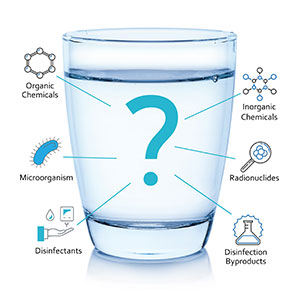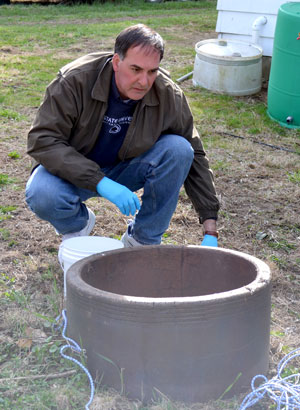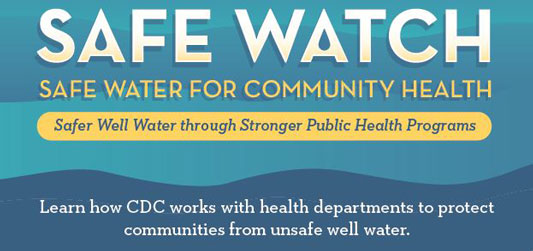Jun 26, 2019
Running Clear: Preventing Private Water Sources from Becoming a Health Hazard in Rural America
by Jenn Lukens
 Everyone depends
on clean water to stay healthy. But for some rural
Americans, clean water is not a guarantee.
Everyone depends
on clean water to stay healthy. But for some rural
Americans, clean water is not a guarantee.
With the introduction of the 1974 Safe Drinking Water Act enacted by Congress, public water systems are subject to regulations enforced by the United States Environmental Protection Agency (EPA). The intent is to ensure that water sources are protected and purified from naturally occurring and manmade contaminants. But unlike public water systems, private wells are not subject to those regulations, making the estimated 43 million Americans who rely on private water sources – many of them in rural areas – more susceptible to health risks from waterborne contaminants.
To ensure that well water is safe to drink, private water systems must be properly designed and regularly tested, treated, and maintained. Failure to take action to prevent or treat contamination in water supplies can cause short-term and chronic illnesses.

What's in the Water? Just Because It Looks, Tastes, and Smells Fine Doesn't Mean It Is
A study conducted by the U.S. Geological Survey of private wells from across the country found that 23% of them had at least one contaminant “at a level of potential health concern.” But many private well owners are unaware of the health threat that some contaminants pose.
Brian Hubbard, MPH, is the Safe Water Section Lead in the Water, Food, and Environmental Health Services Branch of the Centers for Disease Control and Prevention (CDC)'s National Center for Environmental Health. In his position, Hubbard plans and directs a program to protect private well owners from environmental hazards. “Rural Americans are born into or choose to live in situations where they don't have access to water that is federally regulated – no one actively monitoring – so private well owners have to do it on their own,” explained Hubbard.
The EPA has identified and categorized contaminants known to be harmful to human health if they surpass maximum contaminant levels. While private wells are not subject to National Primary Drinking Water Regulations, the standards can be a starting point for private well owners to know what to look for.
EPA's National Primary Drinking Water Regulations are categorized into 6 groups:
 are commonly
found in drinking water. Those that are harmful to
human health – E. coli and Giardia, for instance – can
be a source of contamination when a private well is
improperly constructed or the well water comes from a
shallow source. Testing for coliform bacteria, an
indicator bacteria that is not itself harmful, is the
common approach used to determine if a water source is
safe from microbial contamination.
are commonly
found in drinking water. Those that are harmful to
human health – E. coli and Giardia, for instance – can
be a source of contamination when a private well is
improperly constructed or the well water comes from a
shallow source. Testing for coliform bacteria, an
indicator bacteria that is not itself harmful, is the
common approach used to determine if a water source is
safe from microbial contamination.
 Organic
chemicals are constantly changing as new industry
methods and materials continue to emerge. Poly-
and perfluoroalkyl substances (PFAS) found in
products like cookware, food packaging, stain
repellents, and firefighting foams are some examples of
emerging contaminants that are being studied for their
effects on cholesterol levels, immune systems, infant
birth weights, and thyroid hormones.
Organic
chemicals are constantly changing as new industry
methods and materials continue to emerge. Poly-
and perfluoroalkyl substances (PFAS) found in
products like cookware, food packaging, stain
repellents, and firefighting foams are some examples of
emerging contaminants that are being studied for their
effects on cholesterol levels, immune systems, infant
birth weights, and thyroid hormones.
 Most of the
radionuclides found in drinking water come from the
erosion of natural deposits like uranium. Ingesting
water with radionuclides can have a toxic effect on
kidneys and increase the risk of cancer.
Most of the
radionuclides found in drinking water come from the
erosion of natural deposits like uranium. Ingesting
water with radionuclides can have a toxic effect on
kidneys and increase the risk of cancer.
 Inorganic
chemicals, like lead from aging pipes, continue to
affect the health of individuals across the nation.
Because there is no safe blood lead level for children,
that population is the
most susceptible population to health risks from
lead. Replacing pipes can be expensive and a large
undertaking for rural communities and homeowners, so
other methods such as corrosion control, treatment
devices, and reverse osmosis can be used to lessen or
remove lead in water supplies.
Inorganic
chemicals, like lead from aging pipes, continue to
affect the health of individuals across the nation.
Because there is no safe blood lead level for children,
that population is the
most susceptible population to health risks from
lead. Replacing pipes can be expensive and a large
undertaking for rural communities and homeowners, so
other methods such as corrosion control, treatment
devices, and reverse osmosis can be used to lessen or
remove lead in water supplies.
 Several
disinfectants can be used to treat water, chlorine
being the most common and more effective public health
measures used to minimize waterborne diseases since the
early 1900s. When disinfectants exceed the maximum
contaminant level, they can cause symptoms such as
eye/nose irritation, anemia, stomach discomfort, and
can have negative effects on children and infants'
nervous systems.
Several
disinfectants can be used to treat water, chlorine
being the most common and more effective public health
measures used to minimize waterborne diseases since the
early 1900s. When disinfectants exceed the maximum
contaminant level, they can cause symptoms such as
eye/nose irritation, anemia, stomach discomfort, and
can have negative effects on children and infants'
nervous systems.
 Chemical
reactions to disinfectants can produce
disinfection byproducts such as total
trihalomethanes (TTHMs), which are known to increase
the risk of cancer and other health problems. But the
risk of using disinfectants is minuscule compared to
the risk that foregoing them can have on human health.
Chemical
reactions to disinfectants can produce
disinfection byproducts such as total
trihalomethanes (TTHMs), which are known to increase
the risk of cancer and other health problems. But the
risk of using disinfectants is minuscule compared to
the risk that foregoing them can have on human health.
This image depicts the effect that harmful waterborne contaminants can have on the body:

In Your Own Backyard: Treating Wastewater On-Site to Protect Other Water Sources
One in five homes in the United States have a septic system, also known as On-site Waste Water Treatment Systems (OWTS). Within these private infrastructures, wastewater moves through a series of natural filters to be purified. The purified water is then released into the ground where it eventually flows into nearby streams, aquifers, and other water sources.
Chuck Cousino, REHS, is the OWTS Program Coordinator for the Colorado Department of Public Health and Environment. With a background in civil engineering, he advocates that the design and management of an OWTS are important pieces to preventing harmful substances from eventually ending up in the homeowner's water source.
“In most rural areas, groundwater is used for drinking water, so if you're not properly treating your wastewater, you could be contaminating everyone's water source,” he said. But when system failure occurs due to poorly constructed or managed wastewater systems, the effect on human health can go undetected.
“One of the limitations of On-Site Wastewater Treatment Systems is that, when something goes wrong, it's underground,” said Cousino. “It's not like a municipal wastewater plant that leaks 50,000 gallons of sewage where people can see and report it. Once it's in the groundwater, you typically don't know it until the problem occurs, and then it's too late.”

Colorado has taken some measures to protect the health of rural residents using On-Site Wastewater Treatment Systems. In 2013, the state implemented Regulation 43, which provided more technical guidance for site evaluation, design, construction, and maintenance of OWTS in order to reduce the risk of disease and promote system longevity. Local health departments handle most of the guidance for OWTS to ensure owners are aware of how their systems function, as well as their limitations. They share tips to keep the septic system working properly, like when and how to pump the tank, avoiding drain cleaner which can kill good bacteria in the septic system, and doing laundry throughout the week to prevent a possible system overload.
In this video produced by the Colorado Rural Water Association, Chuck Cousino and other colleagues share the importance of properly functioning OWTS to protect water quality:
Putting Water to the Test: Analyzing Water Sources Can Avoid a Threat
Bryan Swistock is the Senior Extension Associate and Drinking Water Team Coordinator at Penn State Extension. He travels weekly to rural communities, homes, farms, and other businesses educating residents on water quality and systems management. He also creates educational materials to share with rural residents.

One of the biggest barriers facing water purity for rural populations, Swistock pointed out, is indifference. “As long as water comes out of the faucet when they turn it on – as long as it doesn't smell or stain things and it tastes relatively good – they don't worry about it,” said Swistock. “But unfortunately, the cruelty of nature is that a lot of the things that harm you don't cause those problems – they don't stain, they don't smell, and they don't taste – but they make the water dangerous to drink.”
Testing kits are readily available at Penn State Extension offices across the state, but the difficulty for residents is deciphering the results that come back from the lab. “That can be a challenge because the water test reports are often like a second language,” explained Swistock. “Imagine you went to a doctor's office and they handed you your blood test results. When you ask them what it means, they say, 'I don't know. That's up to you to figure out. I just test it for you.' That's what happens a lot of times with water testing.”

This is where water educators like Swistock come in. He uses Penn State Extension's online Drinking Water Interpretation Tool, adapted from other models, to help people decipher what those water test reports mean and if there is cause for concern. But not all rural residents can afford to get their water tested, let alone treated. (Depending on the reason for the test, costs can range from $10 to $1,000).
Other concerns expressed by rural residents involve changes to their environment, such as a new industry or building project, that might impact their water supply. “If something's happening around them and it's out of their control, they want to know what to watch out for,” said Swistock, adding that some fears might be baseless, some are valid, and others just require a simple change. He suggests rural residents test their water through a state-accredited water testing lab before a known change takes place and retest afterwards to compare the differences and act on a potential threat.
With only six Penn State Extension water resources educators to serve the entire state, Swistock has also helped develop a program to amplify their efforts. The Master Well Owner Network (MWON) operates similarly to a community health worker program in that it brings education and one-on-one assistance to rural residents. Funded by the Pennsylvania Department of Environmental Protection, Pennsylvania Ground Water Association, and other agencies, more than 200 Pennsylvania-based MWON volunteers teach 3,000 private well owners each year how to keep their water pure.
“The idea was that maybe we can train an army of people who are all out in their communities and can talk to their neighbors, friends, and coworkers, providing this basic information,” said Swistock.
The Glass is Half-Full: Education and Training Provide a Different Perspective
The Illinois State Water Survey (ISWS) was founded in 1895 to systematically document water quality in Illinois following cholera and typhoid outbreaks throughout the state. Since then, ISWS has collected thousands of water well logs and related information. The only water survey entity in the nation, the ISWS has become a national leader in support for private well owners through education and training.
Steve Wilson, Groundwater Hydrologist and 30-year veteran of ISWS, provides technical assistance for rural Illinois communities and private water systems. Like many of the people he serves, Wilson grew up drinking water supplied from a hand-dug well on his family farm. These wells are more of a risk to surface contamination. “When we had a big rain storm, our water was cloudy for a couple of days because it was susceptible to surface runoff,” said Wilson. Although he can't prove any sickness originated from their water supply, “I'm sure our water always had coliform bacteria in it, and I'd bet E. coli at times – it was in a livestock pasture.”

Wilson believes that a lack of education for well owners is one reason private wells are a health risk. “The only way we are going to reach well owners is through outreach and education. Our hope is that our efforts will result in an eventual increase in the overall knowledge of well owners around the country,” said Wilson.
The Rural Community Assistance Partnership (RCAP) manages a federal program funded by the EPA that provides training, technical assistance, and support to rural communities and private well owners. Through a partnership with RCAP, ISWS manages The Private Well Class, a website that teaches well owners and water practitioners (sanitarians, drillers, installers, and maintenance workers) about preventing health risks through courses on basic well ownership, operation, and contamination prevention.
Wilson's educational efforts also extend to local public health departments, 60% of whom regulate, inspect, and license private drinking water sources. But there is often a disconnect between local public health offices and water practitioners. Getting everyone on the same page is one of ISWS's missions. With RCAP grant funds, ISWS organizes a national annual private well conference that brings groundwater experts, well practitioners, and educators together with public health professionals for discussion, collaboration, and learning.
Keeping WATCH: Federal Program Equips Public Health Agencies

CDC's Hubbard believes that the role of medical providers should not be overlooked when it comes to water's effect on health for rural Americans. “Although a household relying on a private well might have issues that they report to a clinician or physician, it may never be associated with their drinking water system,” he said. This is where education from public health agencies can be of value. “I think medical providers are increasingly interacting with their public health partners and colleagues, so when public health agencies know about contaminants in drinking water in communities where residents rely on private wells, they can share their educational materials with clinics and physicians.
Through the Safe Water for Community Health (Safe WATCH) program, CDC provides funding and technical assistance to local and state public health agencies to educate their communities on safe practices for private water sources. For the 2015 to 2020 grant cycle, 19 state and county public health agencies and departments are receiving Safe WATCH funds to work within their communities, offering well tests, water quality analysis, and recommendations on cost-effective treatment methods. “It's about building environmental and public health capacity so that homeowners have services at the local level,” said Hubbard.
Because waterborne contaminants vary from one community to the next, Safe WATCH state and county coalitions have been collecting and analyzing water contaminant data and identifying local risks. Their findings are translated to maps and made publicly available so residents can target their testing to known contaminants in their area. With this knowledge, healthcare providers can be more aware of the potential health risks for patients with private wells.
Another important piece of Safe WATCH is education in the wake of disasters. When the Great Smoky Mountains wildfires broke out in eastern Tennessee in 2016, damage to private well infrastructures jeopardized the water supply for many rural Tennesseans whose property was affected by the fire. Safe WATCH partners in other states quickly pulled together educational materials for the Tennessee Department of Health to distribute to private well owners following the devastation.
Hubbard also stressed the importance of public health and environmental agencies working together so that messaging to private well owners is consistent. “All of these groups might have interactions with homeowners who have private wells. So how they share and organize their data as one collaboration becomes very useful,” said Hubbard. “There are ways to collaborate, and I think it's an important way to increase outreach to well owners.”

